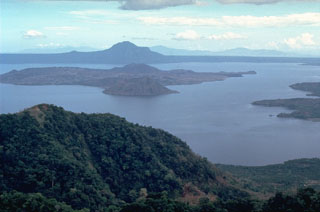Report on Taal (Philippines) — 2 July-8 July 2025
Smithsonian Institution / US Geological Survey
Weekly Volcanic Activity Report, 2 July-8 July 2025
Managing Editor: Sally Sennert.
Please cite this report as:
Global Volcanism Program, 2025. Report on Taal (Philippines) (Sennert, S, ed.). Weekly Volcanic Activity Report, 2 July-8 July 2025. Smithsonian Institution and US Geological Survey.
Taal
Philippines
14.0106°N, 120.9975°E; summit elev. 311 m
All times are local (unless otherwise noted)
The Philippine Institute of Volcanology and Seismology (PHIVOLCS) reported increased seismicity at Taal. No volcanic earthquakes were recorded by the seismic network during 1-4 July, but two low-frequency volcanic earthquakes were detected on 5 July. A distinct increase in volcanic tremor began at 0337 on 6 July and continued at elevated levels through the day. Low levels of sulfur dioxide had been emitted in June with daily averages of 478 tonnes per day (t/d) on 2 July and 377 t/d on 4 July. Daily gas-and-steam emissions rose as high as 1.8 km above the crater rim and drifted mainly NE, though emissions became noticeably absent around the same time as increased seismicity. PHIVOLCS warned that the increased seismicity and lack of emissions may indicated a blockage and increased pressurization, potentially leading to a phreatic event. The Alert Level remained at 1 (on a scale of 0-5); PHIVOLCS reminded the public that the entire Taal Volcano Island (TVI) was a Permanent Danger Zone (PDZ) and recommended that the Main Crater and areas along the Daang Kastila fissure should remain prohibited. Pilots were warned to avoid flying over TVI.
Geological Summary. Taal is one of the most active volcanoes in the Philippines and has produced some powerful eruptions. The 15 x 20 km Talisay (Taal) caldera is largely filled by Lake Taal, whose 267 km2 surface lies only 3 m above sea level. The maximum depth of the lake is 160 m, with several submerged eruptive centers. The 5-km-wide Volcano Island in north-central Lake Taal is the location of all observed eruptions. The island is composed of coalescing small stratovolcanoes, tuff rings, and scoria cones. Powerful pyroclastic flows and surges have caused many fatalities.
Source: Philippine Institute of Volcanology and Seismology (PHIVOLCS)

